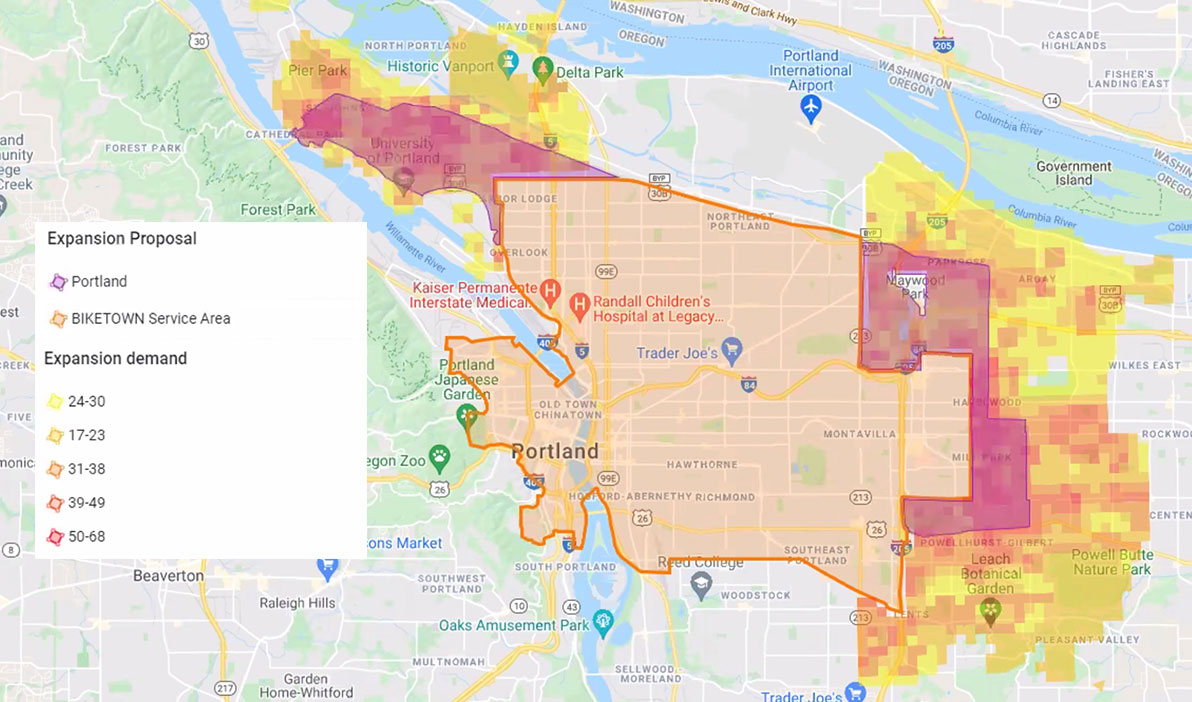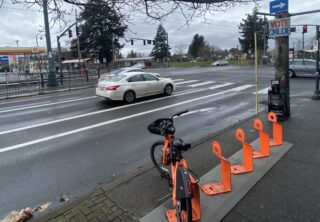Cycling News & Blog Articles
From St. Johns to Mill Park: Biketown set to expand into north and east Portland

Draft PBOT map of upcoming Biketown expansion. Light orange is existing service area. Magenta is proposed expansion. Squares show demand map of public input.
Remember back in June when we shared news of an upcoming Biketown service area expansion and encouraged you to tell the Portland Bureau of Transportation where new Biketown stations should go? At last night’s Bicycle Advisory Committee meeting PBOT revealed the results of that outreach.
Get ready to ride if you live in St. Johns, Kenton, Mill Park, or Parkrose!

A station on N Interstate and Lombard, the northern edge of the current service area.
(Photo: Jonathan Maus/BikePortland)
Here’s what we learned at Tuesday’s meeting…
According to an overview of the current system from Biketown Senior Operations Manager Kanika Agrawal, bike share ridership numbers have almost recovered to pre-Covid levels. Agrawal said there are over 200 stations (a mix of Biketown-branded and geofenced parking at blue staple parking corrals) and they’ve logged nearly 365,000 trips since the big expansion and addition of e-bikes in September 2020. She also shared that since the 13-mile service area expansion last year, 13% of all rides taken were in north and northeast Portland and 6% of them were in east Portland.
The top five busiest stations in the 2020 expanded service have been: Mt. Tabor Park, Portland Mercado (SE 72nd and Foster), NE Ainsworth and Grand, Peninsula Park, and Woodlawn Triangle.
In addition to assessing existing rider behaviors, PBOT used BAC committee feedback and public survey responses (500 responses and 1,500 station locations) garnered this past summer to come up with a new service expansion plan.
Also at last night’s meeting, PBOT Bike Share Program Manager Steve Hoyt-McBeth put the upcoming expansion into context. When Biketown launched in 2016 it had a service area of just nine square miles. With a 13 square mile expansion last year the map covered 32 square miles of Portland. The next expansion on the table would boost the footprint another eight square miles. “When you look at the entire footprint of the city [that] seems fairly small. But for bike share it’s actually very big… that’s almost doubling the original service area.”
Advertisement
Based on feedback and a list of criteria (above), the proposed expansion will reach into downtown St. Johns in the north and the 122nd Avenue corridor in the east as far south as Powell Blvd. This means we’ll see Biketown stations and bikes in places like Cathedral Park, around the University of Portland, Kenton and the New Columbia neighborhood in north Portland. And in east Portland, folks will be able to hop on an orange e-bike in places like Parkrose Transit Center, the Powell Blvd corridor, David Douglas High School, and so on.
“What we’ve heard is that it’s just not financially feasible without public money… I think it’s beyond time to revisit this conversation.”
— Iain MacKenzie, BAC
BAC members had a few questions and concerns for PBOT staff. One of them, Reza Farhoodi, pointed out that a larger service area without adding new bikes would only dilute the service. “It’s already an issue finding availability of bikes at stations. So is there an update on when we might expect to see more bikes added to the fleet?” he asked. That issue is on the radar, PBOT’s Hoyt-McBeth replied, but he had no specific timeline to share.
BAC member Catie Gould questioned why no service would be added to the mid-southeast neighborhoods like Woodstock and Mt. Scott-Arleta. Hoyt-McBeth said they’re aware of demand in those areas, but they didn’t score high enough in the city’s equity analysis.
The most popular comment of the night came from Iain MacKenzie, who said it was time for the city to make good on its promise of a “citywide” Biketown system by investing public funds. Despite Biketown’s success as a public transit system, initial skepticism and general anti-bike bias has fueled a “no public funding” stance since the idea was first hatched in 2007. “What we’ve heard is that it’s just not financially feasible without public money,” MacKenzie said to Hoyt-McBeth. “And I know that before it even launched City Council was very adamant about not putting any public money into Biketown. None of those [council] members against [the funding] still sit on City Council. So I think it’s beyond time to revisit this conversation with city council and say, if we really want to make this citywide, this is the amount of money we need to put into it.”
Hoyt-McBeth thanked MacKenzie for his feedback and offered no other response.
Stay tuned for the full public reveal and more details of the service area expansion.
![]()
Jonathan Maus is BikePortland’s editor, publisher and founder. Contact him at @jonathan_maus on Twitter or via email at This email address is being protected from spambots. You need JavaScript enabled to view it. or phone at 503-706-8804 (texts ok).


